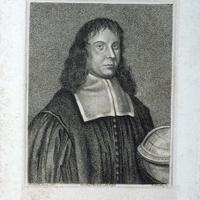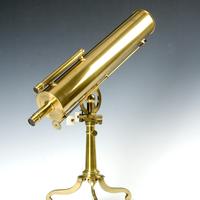Gregorian Telescope
Lynn Atkin shows how reflecting telescopes help us explore even deeper into space
https://www.youtube.com/embed/vjhZa4GjDas
Inventory Number: 90369
You may be familiar with photographs of distant galaxies taken with modern-day telescopes — such as the Hubble or James Webb Space Telescope — which have the capacity to penetrate deep into space.
The Hubble and James Webb are both reflecting telescopes, which means that the main magnifying component is a curved concave mirror a bit like a pocket face mirror.
This type of telescope was developed in the 1600s CE and had several advantages over the conventional refracting telescope.
How does a reflecting telescope work?
With a wider aperture and a depth of field, reflecting telescopes collected more light, providing a brighter image. That meant they were often favoured by amateur astronomers.

James Gregory (1638-1675), Scottish mathematician and designer of the Gregorian telescope
This particular instrument is known as the Gregorian-type reflecting telescope. It’s named after James Gregory (1638-1675), a Scottish mathematician and astronomer who designed the original in 1663 CE.
Unfortunately Gregory didn't have the skills to make the mirrors for the telescope, and it wasn't until 10 years later that he was able to recruit Robert Hooke to help him build it — five years after Newton has successfully built his own reflecting telescope.
Unlike the refracting telescope, which uses lenses, reflecting telescopes use an arrangement of concave mirrors to magnify the object. The mirrors are mounted inside a brass barrel which is on a stand to add stability.
More elaborate Gregorian telescopes like this one also have a small telescope attached to the main barrel to help align the telescope with the object.
Light from a distant object enters the telescope and travels down to the larger primary mirror at the bottom of the barrel.
The primary mirror reflects the light back up towards a smaller, secondary mirror located some way up the barrel. This in turn reflects light back down through a small aperture in the primary mirror, where it is then brought into focus by the eyepiece lens.
Beside the eyepiece, there's a knob which focuses the telescope by adjusting the distances between the mirrors.
The age of professional space telescopes
At first these telescopes were mostly used by amateur astronomers. It wasn't until the 1700s CE and William Herschel that they became popular with professionals. Herschel showed that reflecting telescopes could be used to explore deeper into space and to map in ever more detail the constellations of the heavens.
Exploring deep space with reflecting telescopes is still happening today, with instruments like the Hubble and James Webb space telescopes.






